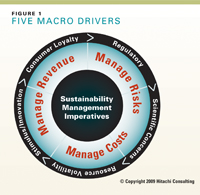Thomas Bornemann of Clarkston Consulting on TPO and DSRs
 A Demand Signal Repository (DSR) is emerging as one of the foundational building blocks of a demand-driven model. But what exactly is it and how can it help? In short, it's an integrated collection of demand data from many disparate sources, such as point-of-sale (POS), syndicated, loyalty, internal analytics and ERP systems. It creates a baseline you can use to measure true demand sensitivity. This newly centralized source of data defines what "sensing and shaping" of the demand curve really means -- because it is now finally possible to monitor events at the UPC/store level. This refreshing view offers nimble companies the chance to micro-segment consumers and customers and create unique pricing, promotional and demand fulfillment strategies that are far more granular than ever before.
A Demand Signal Repository (DSR) is emerging as one of the foundational building blocks of a demand-driven model. But what exactly is it and how can it help? In short, it's an integrated collection of demand data from many disparate sources, such as point-of-sale (POS), syndicated, loyalty, internal analytics and ERP systems. It creates a baseline you can use to measure true demand sensitivity. This newly centralized source of data defines what "sensing and shaping" of the demand curve really means -- because it is now finally possible to monitor events at the UPC/store level. This refreshing view offers nimble companies the chance to micro-segment consumers and customers and create unique pricing, promotional and demand fulfillment strategies that are far more granular than ever before.However, although DSRs have received a lot of attention over the past 24 months, they have failed to truly align with Trade Promotion Optimization. DSRs are commonly linked to three major benefit areas:
- Supply chain - improved forecast accuracy, inventory reduction and out-of-stock reductions
- New product launches - far more actionable and predictive demand data for new products
- Trade promotion analytics - a common foundation for monitoring effectiveness and efficiencies of promotions
The most common use of POS data over the past eight years has been in the supply chain space. AMR Research recently found that 56 percent of all DSRs are used for demand forecasting improvements, the highest category among all reasons for using DSRs. This supply chain-centric view, however, diminishes the overall value of DSRs. To unlock much more value, tightly integrate DSRs with your promotional activities, pricing changes and new product launches. In short, you must move DSRs from your supply chain and IT organizations to your marketing and sales teams. 
The major reasons for this gap between DSRs and the demand functions of trade, shopper marketing and new product launches are:
- Organizational structures
- Inadequate capabilities to execute marketing and sales activities at the micro-segment level
- Lack of results with trade promotion optimization versus trade promotion management
First, organizational structures are often to blame for the gap in alignment of DSRs and trade promotions. DSRs are still largely IT led and owned, while sales and marketing do not understand the value, the role and the benefits that integrated DSRs offer.
Reasons two and three are interlinked and basically come down to the inability to execute many small promotions at micro-levels, and a lack of understanding regarding how it relates to optimizing trade spending. The primary driver in optimizing trade is to create a learning sales organization that becomes highly skilled in developing, executing and monitoring many small, unique trade events that continually "test the water." Equally important would be using this knowledge to optimize your trade events. DSRs are an absolute necessity to enabling trade promotion optimization.
As Figure 1 shows, the consumer products industry continues to migrate toward the individual consumer and, thus, will demand the tight integration of DSRs and Trade Promotion Optimization. We look forward to the day when leading companies have a DSR czar within the global or national sales teams.
